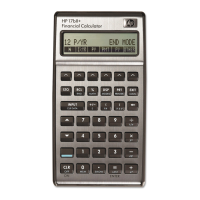14: Additional Examples 217
File name : English-M02-1-040308(Print).doc Print data : 2004/3/9
The following example assumes that you have entered the NOTE
equations into the Solver. For instructions on entering Solver equations,
see “Solving Your Own Equations,” on page 30.
Example:Price and Yield of a Discounted Note. What are the price
and yield of the following U.S. Treasury Bill: settlement date October 14,
2003; maturity date March 17, 2004; discount rate 8.7%? (Assume
month/day/year format.)
Select the NOTE:PRICE equation in the Solver.
Keys: Display: Description:
Creates menu.
10.142003
Stores known values.
3.172004
8.7
100
Calculates price.
e]
Displays NOTE:YIELD
equation, then its menu.
Calculates yield.
Statistics
Moving Average
Moving averages are often useful in predicting trends in data taken over
a period of time. In moving-average calculations, a specified number of
points is averaged. Each time a new point is acquired, the oldest point
is discarded. Thus, the same number of points is used in each
calculation.

